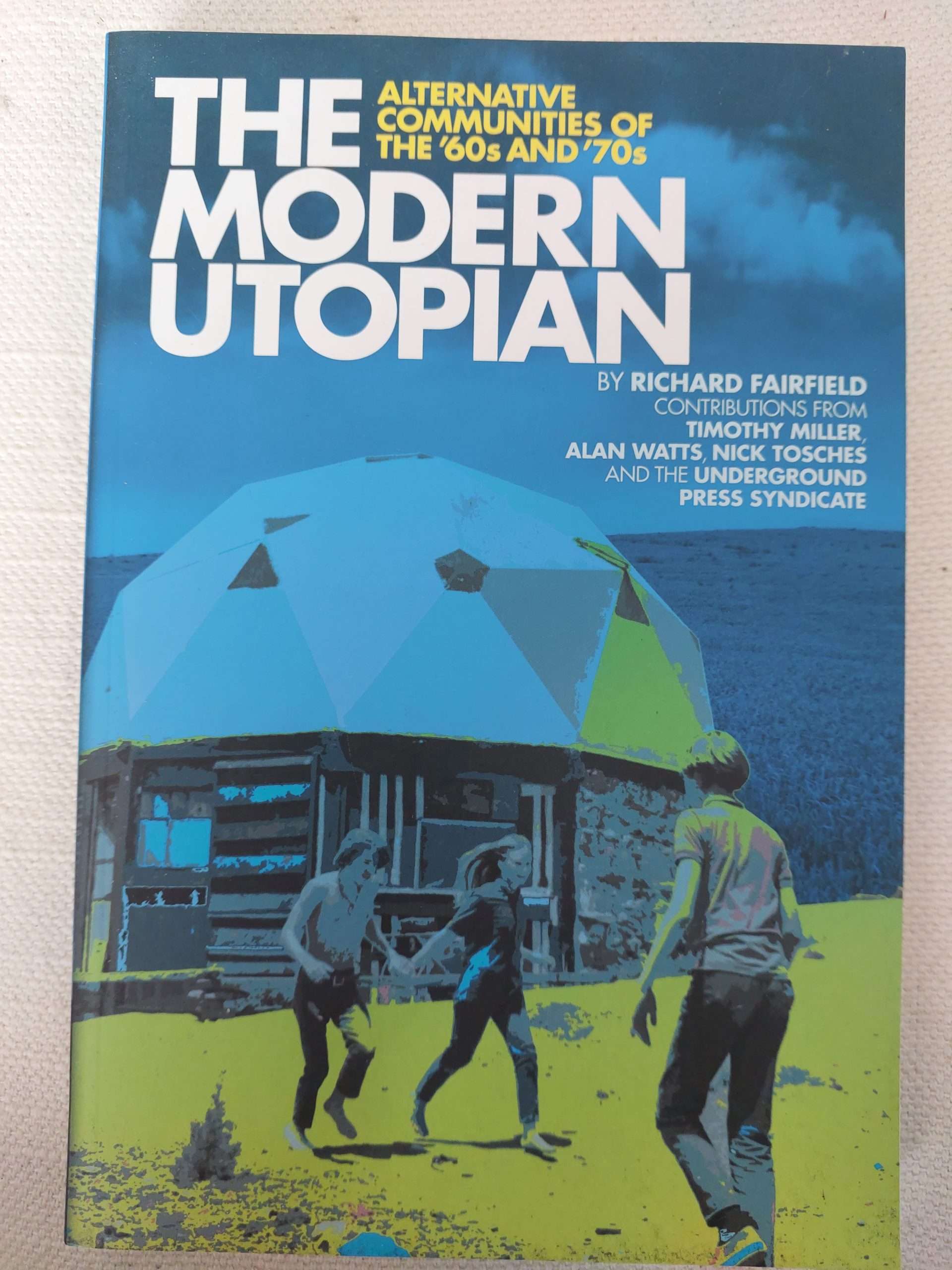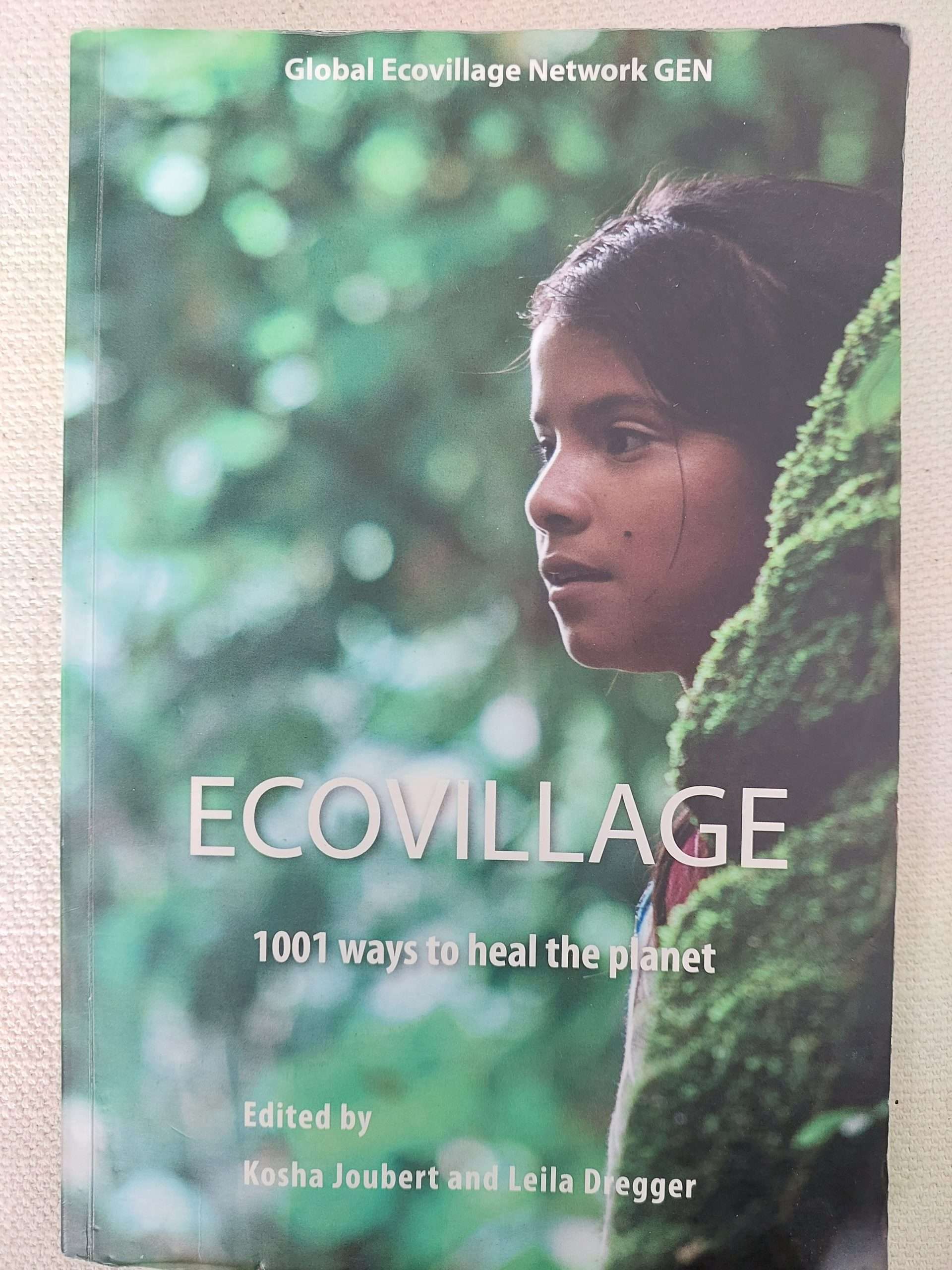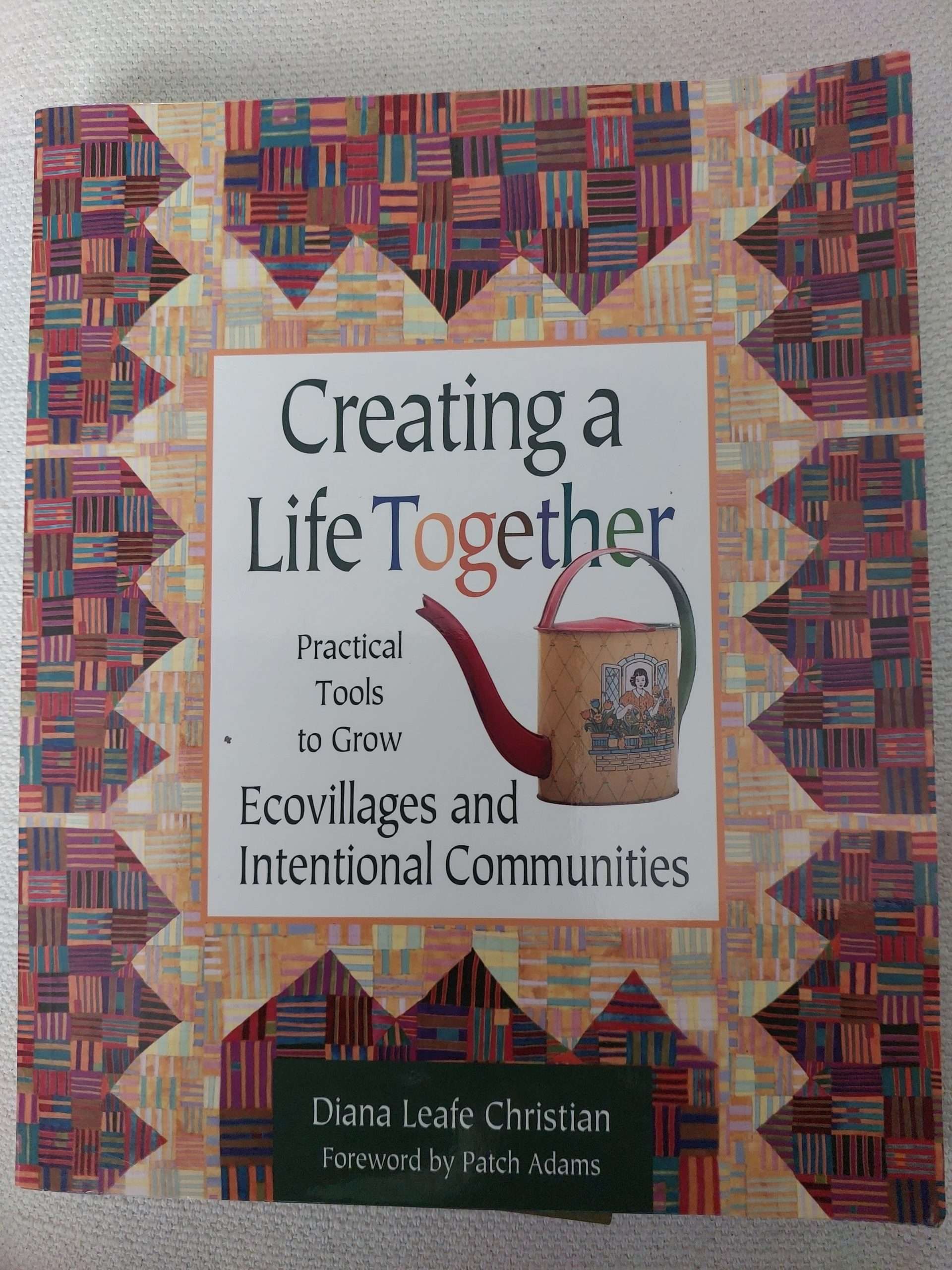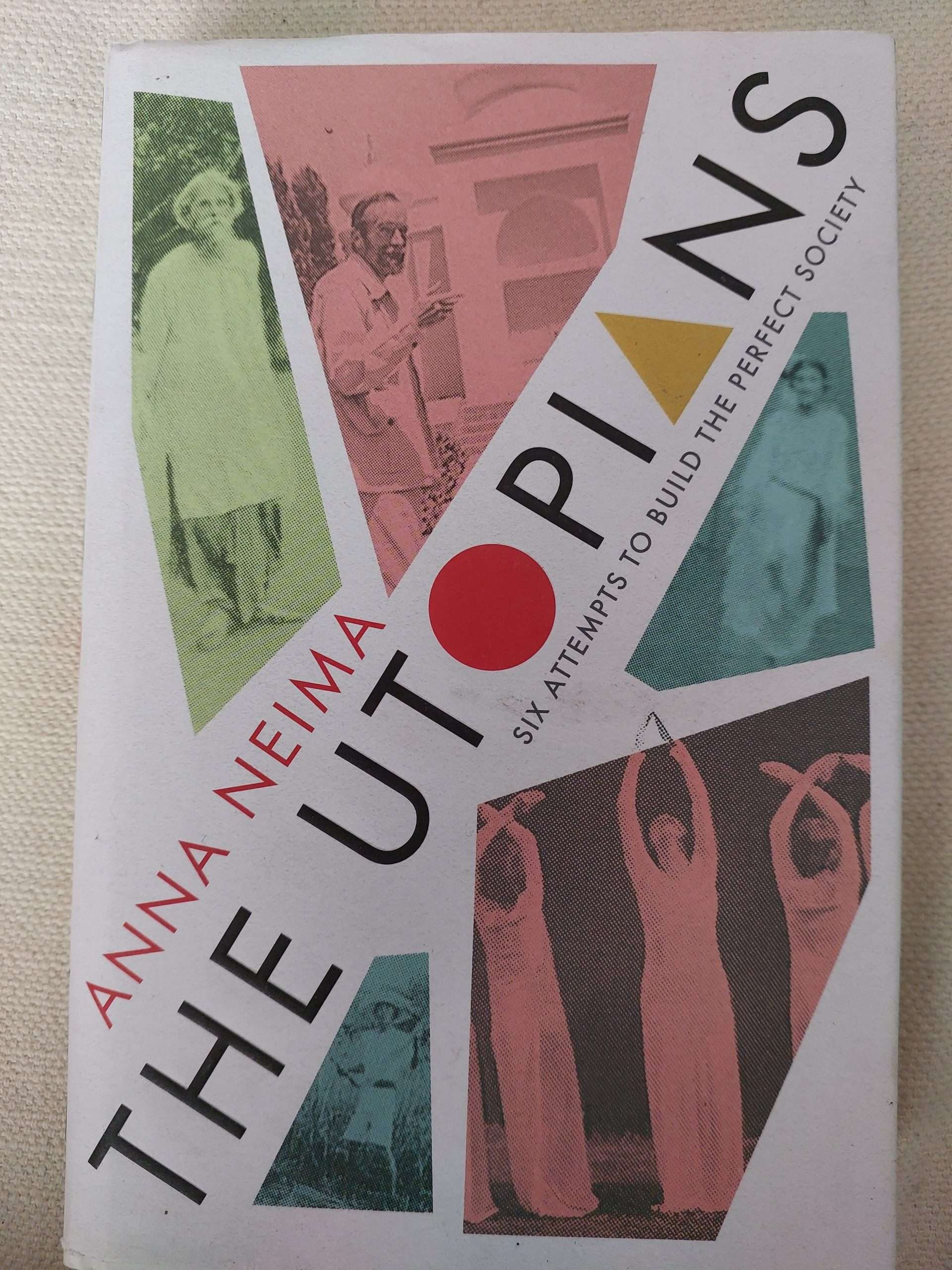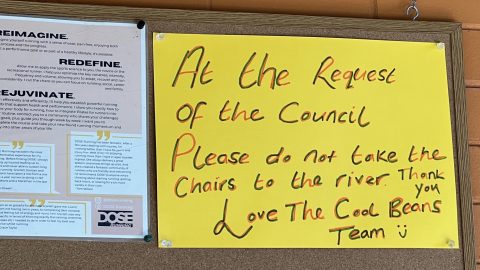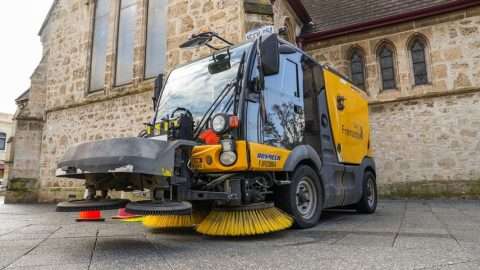Early in 2023, I began a book project – propelled by a long-standing curiosity about how humans resolve differences, stemming in part from my work as a mediator and assisting community groups where difficult issues have arisen. Over the past three decades I’ve spent roughly equal time in Denmark, on the south coast of Western Australia, and in Fremantle, further up the west coast. Both are well-known habitats for folk who are not necessarily attuned to mainstream culture. In reaching out for something different – something that addresses values such as egalitarian decision-making, sharing of resources, communal living, networks of support beyond the nuclear family, and a more sustainable and less materialistic lifestyle – committed individuals have been animated to create or join an ‘intentional community’. Not a new phenomenon, but one that engenders more interest and impetus in an increasingly fragmented and polarised world.

Yet, as I’ve yarned and hung out on location with a number of these passionate proponents and learnt about the realities of living the dream, it’s become apparent there are common potholes on the road to a healthy and enduring community. That prompted me to do some face-to-face research, interviewing members about their backgrounds, their motives for joining a community, the structures and processes (or lack of them) and contentious issues that had come up during their time there. My working assumption was that interpersonal conflicts and the dynamics of power would be at the root of many intractable problems in any given community. After interviewing around forty people spread across eight communities within Australia, that assumption is looking fairly solid.
The book is still ‘incubating’, as one of my friends likes to say. But I thought it would be useful to share some preliminary material, particularly for anyone navigating a path to community living.
Who
Who is drawn towards an intentional community? Most of those interviewed were articulate baby-boomers. Some had forsaken their careers and comforts, searching for a more meaningful future. Others had been active in environmental campaigns. A sizeable proportion had elected to live and raise their kids in a rural setting rather than suburbia. Some were travellers, from within Australia and from overseas, wanting a place to settle among like-minded people. Prior knowledge of community life varied, although some had visited places such as Findhorn in Scotland while others had spent time in spiritual communities. Connecting with people with similar values and ideals was a strong motivation; less so perhaps in co-housing communities where affordable accommodation was the prime driver.
Homework
Joining a community is always a leap of faith. But you have a better chance of a soft landing if you have done your research. This might involve talking to existing members, reading material about how the community is run or governed, gaining a good understanding of the legal structure, and any rules or bylaws that affect members in terms of what is allowed and what is not. Often, there is an impetus to sign on as soon as possible for fear of missing out (FOMO). And a tendency to gloss over the fine print of written documents and agreements, trusting it will all make sense. As one interviewee told me:
‘I was naive. Well, you had to read all the agreements. And then you have your interview and then you have a second interview to see how much you’ve understood the agreements. And it’s like I understood the why, but I didn’t understand the how sometimes.‘
This person – and her views were reflected among others – could understand why there were certain things written down but simply reading the documentation gave her no clear information about how the agreements applied in practice. There can be rules about behaviour but are they enforced or enforceable? What happens when disagreements occur, as they inevitably do? Are there clear guidelines laid down and do they work?
Many communities require potential newcomers to spend time as visitors, guests, or tenants before submitting an application for membership. ‘Journey to Joining’ as it is called in one community. This gives the newcomer a chance to live on the property, to attend meetings and busy bees, and to get to know existing members. And it gives those members a chance to appraise the newcomer (and their families). Put another way, a social reciprocity of experience and observation.
Pros and Cons
As with any major decision, writing down the pros and cons can greatly help focus the mind. For a single person this can be a solo exercise but if you’re part of a couple, it can be useful to do this separately and then compare notes. And you may want to show your list to a trusted friend or relative in case they come up with something that should be added or clarified. People with whom I spoke had rarely done an exercise of this nature but one of the questions I asked was: ‘Was your partner or spouse on the same page when you decided to join?’ Most answered in the affirmative. Generally, they had talked it through and come to the same conclusion. Yet community life is not for everyone. Assumptions about what someone else is thinking and feeling can be way off the mark. This can be fatal when you’ve committed heart and soul to a new way of living, and it turns out your agendas were at odds from the start.
Financial Implications
One of the primary considerations relates to finances. Having sufficient savings or access to loan facilities is almost always a bugbear. Unless you will gain freehold tenure – in other words, own – an allocated piece of land, usually through strata or community title, most banks and lending institutions won’t let you borrow to buy in. For joining fees, purchase of shares, and other payments upfront, if you are younger you may need to rely on parents or friends. Or you may need to work longer and harder to save enough money.
That’s usually the first hurdle. The second is accommodation. If you are cashed up from the sale of your home or have other financial assets, you may start with enough capital to have a house built or buy an existing one. If, however, you are moving to a vacant allotment within a new community, you may only be able to afford a caravan or some other form of temporary accommodation. Assuming local government regulations, planning laws and community policies allow you to live on the property while you build, constructing a ‘proper’ home will often stretch out for three or four years, if not longer. Most of the older communities I visited reflected this trajectory. Construction was often piecemeal, depending upon the flow of funds. Recycled materials were sought and used with great creativity. On the plus side, interviewees reported that helping each other build became an integral part of the glue that bonds new members. Moreover, the ‘home building and landscaping phase’ enables engagement with local retail outlets, tradesfolk, and other members of the local community who may be happy to offer advice and suggestions.
Community obligations
Some people seem to love meetings. Most of us do not. Yet being part of a community inevitably involves a commitment to participate in a range of things that require decision-making. This can be demanding. Parenting and work responsibilities, health issues, and other preoccupations may make us tired and resistant. Having to sit down and think and listen, when not at our best, can lead to frustration and anxiety and often disagreement. Yet meetings can also be playful and productive. Again, preparation is a key. Understanding procedures, knowing how and when to speak, and listening carefully to what others say does not come easy to everyone. Clearly, there is a role for spontaneity and intuition – and for humour. But a solid framework helps, and competent facilitation is usually crucial, not to mention turning up in a good head and heart space.
One interviewee commented:
‘For really tricky issues……..like Diana Leafe Christian talks about, what we do when we go to a meeting, we take our values, our strategies, and our emotions. And if we go in and we haven’t done work on those, that’s what we’re dealing with.’
Often, the groundwork has already happened outside the meeting. Working groups, conversation cafés, informal get-togethers, sharing circles, and other gatherings can discuss issues in a more casual setting, less affected by time constraints and the need to churn through an agenda.
Apart from the ‘head stuff’, most communities have commitments that involve physical labour. Regular ‘busy bees’ for cleanup and maintenance, building community facilities, and engaging in fire prevention training and activities, are common examples. From a social perspective, they provide an opportunity for members to meet and mingle. And for those whose bodies are on the wane, there can be scope to compensate, either by cash payments or less physical tasks such as providing refreshments or taking care of administrative duties. One community has a weekly gig they call Helping Hands. In the words of a grateful member: ‘For some of our aging population, it’s been life-changing. They couldn’t afford help if they had to pay people.’
Some vegetable gardens and orchards may be communal. Planting, weeding, pruning and harvesting, as seasons come and go, requires constant care and attention. The enjoyment of homegrown fruit and vegetables can be a shared sweet spot, inducing hands-in-the-dirt satisfaction.
Job opportunities
Location, location, location. For most folk, joining a community does not obviate the need to earn a living. Not all communities are situated within or near a town or city. It can be something of a paradox to move to an enchanting rural location and realise you must commute a fair distance to your workplace, potentially spending more time in your vehicle than feels sensible or sustainable. This is the kind of trade-off that needs to be given careful thought, lest it proves burdensome in the longer run.
I remember visiting Crystal Waters in Queensland in the 1990s. Some residents drove two hours into Brisbane for work; others ranged as far afield as Sydney. Of course, that was before the days of Zoom and working from home (WFH). Nowadays there is more flexibility but for some jobs travel is unavoidable.
Children’s education
Proximity to schools involves parallel challenges to proximity to a workplace. Distances can be long. Roads may be less than perfect. Weather conditions will vary. Public transport may not be available, and parents are needed to fill the gap. This can prompt a community to start their own school and/or preschool, while some parents may prefer to homeschool. Usually there are hoops to jump through, with a State Education Department. But if community members have expertise and persistence, on-site schooling can both save money and reduce stress. (One downside can be that kids are not given the opportunity to integrate with their peer groups in the public or private school systems.)
Mental and physical readiness
I’ve already mentioned that aspiring members are often motivated by the desire to be around people with similar values. But even if this is so, we are all very different, particularly in terms of psychological maturity. Most of those to whom I spoke had done some ‘work on themselves’. They had insights around what might trigger them and others, as well as self-awareness and a sense of responsibility. Many were or had been leaders and facilitators and office bearers within their community. As far as I could tell, my interviewees, by and large, had strong personalities, no shortage of self-esteem, and knew how to express themselves. So, when I extrapolate their comments, I need to keep in mind that others within their respective communities would not necessarily display similar qualities or attributes. Though my invitations were circulated widely, this ‘silent majority’ may not have been keen to participate and so may be unrepresented in my findings.
Communities can and often do offer support to members who are having a tough time. But they are not, officially at least, therapeutic centres. Many of the problems that tend to arise stem from those who bring their unresolved issues with them, along with a naïve expectation that community life will work its magic and their needs met by other members. This is a precursor to discontent. Despite the thoroughness of screening procedures, some new members can turn out to be more takers than givers. This creates a ripple effect within the community where problematic members are given a lot of rope and support without any noticeable behavioural change. If things are left to fester, the problem inevitably gets worse. One of the comments I heard from interviewees was that their procedures had not been strong enough for dealing with these situations. By inference, a kind of ‘bleeding-heart syndrome’ is counter-productive and can be taken advantage of by a particular person or persons.
The ’oh shit’ moment
For most people, the decision to move into an intentional community represents one of life’s Big Choices. It can be hard to foresee what you are giving up, and your idea about what you are likely to gain may soon run up against a brick wall of reality. Regrets, I’ve had a few, crooned Frank Sinatra over 50 years ago, while letting the world know I did it my way. These sentiments may resonate with community members, present and former. With few exceptions, the early years of an intentional community involve significant turnover, not necessarily due to high drama but more because people felt they had given up a sense of personal agency and being part of a collective was too damn demanding.
Formation, Location, and Number of Residents
Is there an ideal way to form a community? An ideal location? And an ideal size? Probably not, if past experiences are any guide. Here is a snapshot of the eight communities from whence I’ve drawn most of my information. There are some similarities but also significant variations:
Moora Moora Cooperative Community (Victoria). Established in February 1974 as a ‘community settlement society’, Moora Moora is about 1 ½ hours by car from Melbourne, and 15 minutes from Healesville, the nearest town. The site occupies 245 hectares, lies 700 metres above sea level with a rainfall of 1075 mm per year. Home to around 50 adults and 20 children spread across eight clusters(mini-villages), the property is protected by a Trust for Nature covenant. In 2024, Moora Moora celebrated its 50th birthday.
The Wolery Ecological Community (WA). Registered in February 1978 under The Associations Incorporation Act, The Wolery is a 15-minute drive west of Denmark, a small town on the southern coast of Western Australia. Occupying 60 hectares, the community is home to around 40 adults, a sprinkling of children, and incorporates 15 house sites.
Bundagen Co-operative (NSW). Established in August 1981 as a rural land sharing cooperative and wildlife sanctuary, Bundagen lies just south of Coffs Harbour on the mid-north coast of New South Wales. Occupying 313 hectares, the community has around 180 members, of whom 110 (with their children) are distributed amongst 12 clusters. About 50% of the land is protected and managed under a Conservation Agreement.
Crystal Waters Permaculture Village (Qld). Set on a 259 hectare property, Crystal Waters began around 1981 as a land cooperative on a rural subdivision north of Brisbane, in a valley west of Maleny. In 1985 it was redesigned as a permaculture village to accommodate between 250 and 300 people within 83 residential lots. Two commercial lots – one for visitors’ accommodation and the other for a commercial village hub, were also incorporated. Under the relevant Queensland legislation, incoming members can purchase a freehold site within a cluster. About 80% of the land is common property and designated as a wildlife sanctuary. Currently there are around 250 residents.
Mia Mia Housing Collective (WA). In 1988, Mia Mia was incorporated as a not-for-profit organisation. From the early 1990s, on around three acres of land purchased by the State Government on the periphery of the Denmark townsite, 15 dwellings were constructed in two stages and funded from government sources. Key objectives include providing secure housing for low-income earners, and managing the property in an sustainable manner. The Collective houses around 25 people and maintains gardens and a common house, with rules and bylaws governing membership, rent and other contributions. Over the years it has alternated between being self-managed and managed by an umbrella co-housing organisation.
Pinakarri Cohousing Community (WA). Located 10 minutes from Fremantle in the suburb of Hamilton Hill, Pinakarri is a small community with around 20 people occupying 12 houses. Formed in 1991 by a nucleus of parents seeking a more socially sustainable way to raise children, the group located a suitable site owned by the Department of Housing. After becoming incorporated, the group obtained Federal funding to purchase the land and to build homes. The homes and common house were architect-designed and founding members took up residence in 1999. The community has equity and non-equity membership, reflecting private ownership of some properties through strata titling, with the majority being public housing rentals.
Narara Eco Village Cooperative (NSW). On former horticultural research land, Narara is 10 minutes from Gosford and half an hour north of Sydney. The property totals around 56 hectares, with about 20% zoned for residential development, around one third for community buildings, agriculture and common gardens, and the remaining areas kept as native forest and bushland. Members purchase a minimum shareholding of $30,000. This investment represents a share in the community land and buildings owned by the Co-operative. If a member chooses to leave the Cooperative and sell their property, their shares can be repurchased by the Cooperative and the property sold on the open market or to a current member. A purchaser is required to become a member and buy shares in the Cooperative before settlement. Though the origins of the Co-op date back two decades, the land wasn’t acquired until 2012, by which time a stage-by-stage development had been planned. Ultimately, there will be 150 lots, ranging from around 450 m² to 700 m² in size.
DecoHousing (WA). This co-housing development is located within a short walk of the Denmark township. The founders formed a proprietary limited company in late 2013 to purchase a plot of land. Ecologically sustainable principles formed the basis of home and landscape design. Local architects, builders, and other professionals were engaged to implement the plan, resulting in 12 residential premises and common house, underpinned by strata title. In 2018 the first residents moved in. Today, most homes are owner-occupied; others are tenanted.
What Makes a Successful Intentional Community?
With increasing environmental awareness, many intentional communities fall under a broad description as ‘Eco Village’. One of my interviewees has been involved with The Global Ecovillage Network (GEN). He spoke about Design Education courses initiated by GEN that ‘basically identified there’s five different things that are necessary for a successful intentional community. The first one is, how does the intentional community function socially? Which is a whole series of questions. The second one is, how does the ecovillage function financially and economically? The third one is, how does it relate to the ecology? In what way is it ecologically strong? The fourth one is, how does it function as a culture? And then the fifth one is, we need to be able to integrate those four into a single pattern.’
These are great questions. They can form the basis of enquiries by people keen to join a community. And they can be revisited in discussions within an existing community as a way of keeping tabs on how members perceive what is working well and what needs more attention.
Investment in People Skills
Those keen on community living may start out with similar aspirations and a shared vision. At the same time, backgrounds, experiences and skill sets will differ. New communities, where homes are yet to be constructed and gardens and orchards established, need people with planning, architectural, building, and horticultural skills, some of which may be sourced from outside but generally fall upon the shoulders of members. Practical, hands-on competency is a basic ingredient in the community pie.
Yet there are other less tangible skills that could be deemed essential. In the words of one of my interviewees:
‘To live in a community, there are three separate areas of skill that are needed. The first one is how do we make decisions as a community? The second is to what degree do the people have rural survival skills? Because a lot of the people who move into a community come from an urban area and they haven’t had much experience living in a rural area. And the third set of skills is the whole question about income. How does a community earn an income? And to sustain yourself in a situation like this needs an entrepreneurial flair.’
I would add a fourth attribute: Emotional intelligence. Put another way, how do we relate to ourselves and to others? How well are we equipped to deal with the rollercoaster of feelings that inevitably arise when we shift from a more private mode of living to one that requires greater interaction with other people? Are we prepared for added stresses that might arise within our own intimate relationships? Do we have the resilience to stay firm and focused when times get tough? Have we the understanding and acceptance that all our personal wants and desires will not necessarily be attuned to those of the community in which we have chosen to live?
Many communities recognise the ebbs and flows of emotions that occur within all of us. Investment in workshops and trainings and involvement in contemplative practices can go a long way to enhance community coherence. Easier said than done. We all have been conditioned and often have patterns we don’t recognise. If these play out and remain unaddressed, dissatisfaction and disharmony will follow.
Socrates’ edict: ‘Know Thyself, rings true. Yet, even with the best of intentions, changing ingrained behaviours is a formidable task. Within a community, as well as sharing and caring, there is an ongoing need to support one another while at the same time challenging unhelpful behaviours in ways that elicit a positive response rather than mere reaction.
It can be a slow process, particularly as there are demands on people’s time and social skills such as emotional intelligence will often be well down the list. It can be the luck of the draw as to whether a community can survive and prosper. In the words another participant: ‘What I see as shortfalls is that we don’t invest in skills to uphold our vision. Yet there’s been ‘a progression in maturity since I was there from ten years to now.’
Structures
We’ve spoken already about agreements and how well they are understood. But it’s also important to get a handle on how a community is set up legally – how the land is owned, and what rights and obligations arise, both collectively and individually. Communities set up in the 70s and 80s tended to be cooperatives, where individual or couple members held shares but did not have legal title to the piece of land they settled upon. Crystal Waters is an exception. More recent creations such as Narara and DecoHousing have also opted for strata title for individual lots with the remainder of the property having a common or shared use.
An embedded challenge involves upholding legal obligations without compromising the vision, values, and objectives upon which the community is based, and the direction in which it is hoped the community will evolve. Communities that endure are often the ones that have found creative ways to tread this delicate tightrope.
Processes – community decision-making
Many of the hard yards emerge from how decisions are made. As a rule of thumb, intentional communities are not pyramid-style hierarchies where power is concentrated in the hands of a single figurehead or a small group. Responsibility for decision-making is shared. Most communities strive for some form of consensus, although this can be constrained by legal requirements that regulate aspects of governance. Some decisions might require a simple majority vote; others may need a two thirds or three-quarter majority before they can take effect. But, in the main, intentional communities try to achieve broad agreement among members when formulating policies or deciding on various aspects of community life.
In the let-it-all-hang out atmosphere in early communities of the 60s and 70s, there was often aversion to rules and structures. But, over time, the ones that lasted embraced the need for clear processes around bedrock aspects of communal living – such as land use, legal obligations, membership, community involvement, and personal behaviour. It dawned on people that notions of universal agreement regarding every facet of decision-making were unworkable. Achieving consensus might be a noble aim but it only took one objector to stymie anything happening. This created undercurrents of frustration and angst. I’ve heard examples of a whole community becoming paralysed by an inability to decide where a tree should be planted or what vegetables should be grown!
Developments in other countries mirror the Australian experience. As a result, new theoretical models emerged. One that has gained traction in intentional communities is Sociocracy – a term coined in the 19th century. Sociocratic principles have evolved over time and a thorough explanation is beyond the scope of this article. Suffice it to say that the process seeks to obtain informed consent from all participants and that decisions occur when objections have been heard and discussed, and no major obstacles remain. Rather than try to achieve consensus – which seeks total agreement from everybody – sociocracy aims to produce consent. Some participants may not agree with a particular course of action but they can live with it. When reflecting upon a proposal, people are invited to consider whether it is both good enough for the time being and safe enough to give it a go. If not, further work is needed to find something sufficiently acceptable to get the green light.
Communication
‘The thing I find is, and it comes back to the definition of community, that we don’t really understand that what determines a successful community is the quality of communication that links the people together. It’s no accident that the word community and the word communication come from the same roots. So we need to spend time focusing on how we improve the quality of communication between all members, renters, non-renters, the people together.’
This observation came from a person with a long association assisting intentional communities. During our conversation I appreciated the connection between the linguistic roots of community and communication. And I resonated with the need to improve the quality of communication between all stakeholders.
Yet I found myself pondering whether a successful community is determined by the quality of communication that links people together. My assessment is that it is necessary but not sufficient. As outlined above, other factors are in the mix. But I get where this person is coming from. ‘Communication’ is a broad term with many strands, language being only one. Choice of words is important; so is tone and timing. Facial expressions convey meaning as does what we call ‘body language’. Listening is the other side of the same coin that contains speaking. And, though it’s not obvious to everyone, silence is an integral facet of how we communicate.
Cultural factors also need recognition if we are to pay serious attention to ‘good communication’. Coming on strong with loud voices and emotional displays may be normal par for the course in one culture but feared or avoided in another. (Think Latin versus Anglo-Saxon.) While some cultures are comfortable with forthright discussions on most topics, others are more circumspect.
As the saying goes, there is a time and a place. Communities are collective entities. There is an ongoing need to meet in groups, large and small. Protocols are necessary to facilitate healthy discourse. Non-observance can wreck meetings and turn people off. If this sounds a bit like the bleeding obvious, it reflects trends in my discussions with community members. Many spoke about difficult decision-making situations, members getting burnt out from taking positions of responsibility, good and poor facilitation, and whether meetings were well attended or avoided. Those of us who have been involved in community groups and nonprofits will probably identify with these considerations. Has the quality of communication – including the overall vibe – left us elevated and enthused – or feeling exhausted and miserable?
Addressing Conflict
In some respects, an intentional community is a microcosm of the wider world. We have all been privy to and involved in some forms of conflictual situations over the course of our lives. From childhood onwards, we have been exposed to parents, family members, authority figures, friends and colleagues, and other humans – including many with whom we do not see eye to eye. Our approach to potential and actual conflict can range from avoidance to aggression, and everything in between. Rarely are we taught to regard this intrinsic fact of life as an opportunity rather than a burden; a blessing rather than a curse. Yet, to borrow a term used by the late therapist, David Schnarch (when talking about committed relationships), conflict can be a ‘people-growing machine’.
This becomes acutely relevant within intentional communities. Whereas couples can separate or maintain a hostile ‘peace’, the multiplicity of interactions within a community render it nigh on impossible to hide (though some members may be disaffected enough to give it their best shot). Thus, any community worth its salt will address the realities of conflict, and work towards processes designed not only to defuse tensions but also to educate and assist members come to grips with the inevitable flareups.
At the core of this education, I believe, is a shared recognition that, leaving aside scenarios involving violence, many encounters with interpersonal conflict present us with a chance to learn and to grow. Avoidance and denial, as with other aspects of our psychological positioning, don’t make a problem go away. But I’m not minimising potential issues that can cause schisms within a community. It takes both intention and attention to head them off at the pass, and to deal with them effectively when they occur.
The enthusiasm to get a community off the ground will often mean ‘social needs’ usually play second or third fiddle to more pressing concerns such as land acquisition, financing, design, growing the membership base, interacting with bureaucracy, and constructing homes and other facilities. Interviewees have confirmed this. We would have had an easier ride if we had attended more thoroughly to this kind of homework, was a common refrain. Neither did we anticipate that those of us who appeared to have a similar vision could end up fighting among ourselves.
Well, I agree that preparation and training can enhance understanding, and policies containing clear and workable conflict resolution procedures should be part of the mix. Most people don’t know how they will react or respond until a serious dispute arises, often out of left field. Another way of putting it is that the map is not the territory. Great theories need to be tested in practice. In my interviews, members were candid about issues that had become disruptive and seemingly incapable of resolution, and how people were left wondering what they had got into.
On the other hand, those who stuck it out tended to be immensely grateful. Without knowing it, they may have absorbed the edict of a former Australian Prime Minister: ‘Life was not meant to be easy’. Indeed. And in at least one community, I read introductory material that emphasised how conflict is inevitable and should be treated more as an invitation to connect than a threat to disband.
Wrapping up
Drawing from the rich commentaries with community members, and my own lived experience and ideas, I’ve offered a few pointers for those who aspire to move out of the mainstream. Though there can be an irresistible urge to jump in and commit to a new venture, a crucial counterweight will revolve around accumulating information from a range of sources and conducting reality checks based on your own particular circumstances. Once aboard the community bus, you will be better equipped for what might follow.
A beacon of hope? This article has raised a panorama of legal, financial, practical and psychological considerations for wannabe community members. Yet my musings are not intended as a deterrent. Far from it. Intentional communities may play an important role in what lies ahead for humanity. They can be a microcosm of what might be possible in a re-imagined world. A world that has awoken to the urgent need for new political, economic, and religious paradigms. A world where humans at scale understand and embody our interconnectedness with the millions of other species and the biosphere in general.
If we can find a scintilla of optimism within the oceans of despair and brutality that threaten to swamp us the moment we switch on a device or pick up a newspaper, it’s that courageous people, particularly among the young, are rejecting the futility of the status quo and seeking more fulfilling and sustainable pastures. Contemporary worldviews that dominate today may seem entrenched and enduring. But history tells us otherwise. So, rather than dismiss intentional communities as an aberration, let us pay attention and offer support. It might not be the only way to go but sure as hell is one worth pursuing.
By Bruce Menzies. Based in Fremantle, most of the time, Bruce Menzies is the author of three novels, a family history, and a recent memoir. Details at BruceJamesMenzies.com If you’d like to read more of Bruce Menzies’ work on Fremantle Shipping News or listen to a fascinating podcast interview with Bruce, look here
~ If you’d like to COMMENT on this or any of our stories, don’t hesitate to email our Editor.
~ WHILE YOU’RE HERE –
PLEASE HELP US TO GROW FREMANTLE SHIPPING NEWS
FSN is a reader-supported, volunteer-assisted online magazine all about Fremantle. Thanks for helping to keep FSN keeping on!
~ Don’t forget to SUBSCRIBE to receive your free copy of The Weekly Edition of the Shipping News each Friday!
